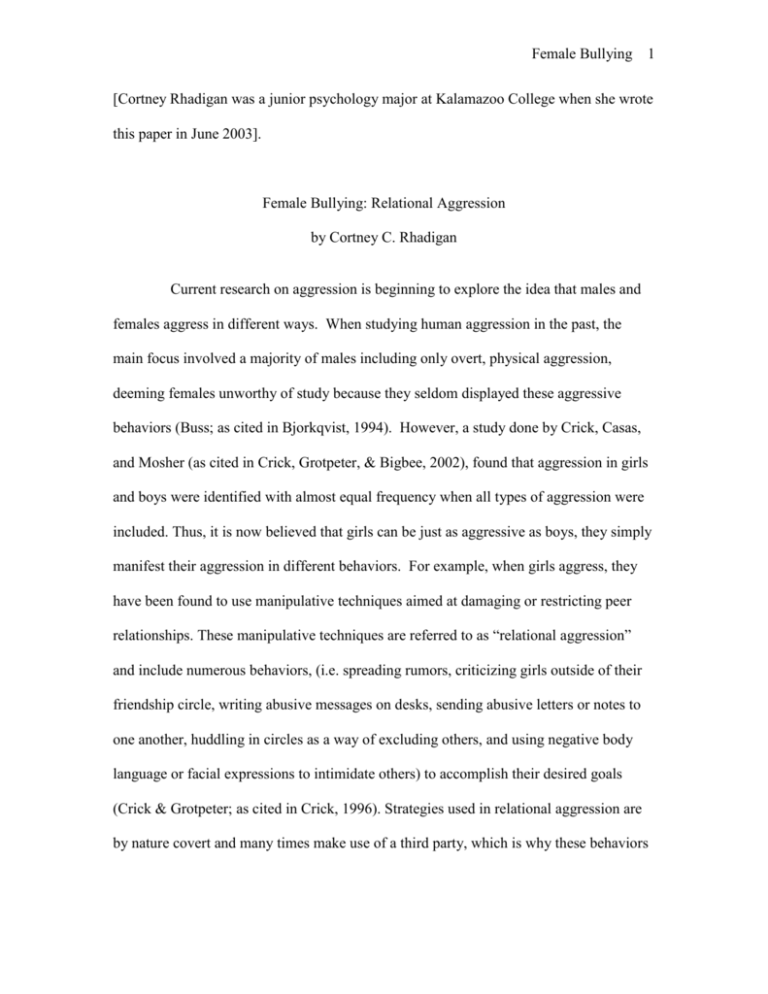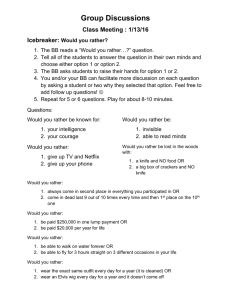Word Version
advertisement

Female Bullying 1 [Cortney Rhadigan was a junior psychology major at Kalamazoo College when she wrote this paper in June 2003]. Female Bullying: Relational Aggression by Cortney C. Rhadigan Current research on aggression is beginning to explore the idea that males and females aggress in different ways. When studying human aggression in the past, the main focus involved a majority of males including only overt, physical aggression, deeming females unworthy of study because they seldom displayed these aggressive behaviors (Buss; as cited in Bjorkqvist, 1994). However, a study done by Crick, Casas, and Mosher (as cited in Crick, Grotpeter, & Bigbee, 2002), found that aggression in girls and boys were identified with almost equal frequency when all types of aggression were included. Thus, it is now believed that girls can be just as aggressive as boys, they simply manifest their aggression in different behaviors. For example, when girls aggress, they have been found to use manipulative techniques aimed at damaging or restricting peer relationships. These manipulative techniques are referred to as “relational aggression” and include numerous behaviors, (i.e. spreading rumors, criticizing girls outside of their friendship circle, writing abusive messages on desks, sending abusive letters or notes to one another, huddling in circles as a way of excluding others, and using negative body language or facial expressions to intimidate others) to accomplish their desired goals (Crick & Grotpeter; as cited in Crick, 1996). Strategies used in relational aggression are by nature covert and many times make use of a third party, which is why these behaviors Female Bullying 2 are many times placed under the main rubric of indirect aggression (Smith, Cowie, Olafsson, & Liefooghe, 2002). With reports of as many as 72 percent of school-aged females experiencing being bullied, it is important to investigate female aggression and it’s relationship with peer victimization (Casey-Cannon, Hayward, & Gowen, 2001). A study done by Crick and Grotpeter found that while both boys and girls experience similar levels of victimization, girls report significantly more relational victimization or socially harmful behaviors than boys do (as cited in Casey-Cannon, et al.). Relational strategies are utilized in female bullying because as girls enter adolescence, they place the majority of their investment into social comparisons and peer acceptance for self-worth, making them particularly susceptible to, and highly aware of, the impressions of others (Casey-Cannon et al.). Therefore, the most effective way to harm a girl is to manipulate her relationships within her peer group, which is precisely the aim of relational aggression (Goodwin, 2002). Yet, female bullying cannot be explained by simply describing the dyadic relationship between the bully and victim, the activity of victimization is a social rather than individual process (Goodwin, 2002). Girls tend to play in small groups in order to allow more intimate situations to talk; socialized to do so from an early age, they emphasize emotions and interpersonal events (Goodwin). Because talking itself is valued, the majority of time in these small groups is spent on commentary about other girls. Therefore, the sharing of social information, such as talking about others’ faults or sharing others’ secrets creates intimacy within these groups and thus, the ability to gossip about others could mean inclusion in these groups (Owens, Shute, & Slee, 2000). To be Female Bullying 3 the holder of the knowledge about the latest gossip or rumors is to possess power (Owens et al.). Consequently, desire to connect with one another fuels close friendships, but need for recognition (popularity) ignites competition and conflict (Goodwin, 2002). Because girls evaluate themselves in reference to their relationships rather than in terms of how they rank in athletic skills or prowess like boys do, social exclusion and ridicule are powerful ways for them to define social order (Goodwin, 2002). As a result, groups are in a continuous process of alliance formation as girls compete with one another about who is friends with whom, and who is excluded. To do so, they talk extensively about each other behind backs, and sanction those who try to act superior (Owens et al., 2000). Membership in these peer groups defines who is “in” and acceptable and who is “out.” Consequently, a self-protection motive is operating within groups, so girls will not oppose the prevailing group opinion for fear of being excluded themselves (Owens et al.) In other words, girls would rather be harassed and hurt than kicked out of their social group because the idea of being ostracized from their group of friends is much more devastating (Simmons, 2002). This idea helps explain why the interactions between a bully and victim can become so stable and entrenched; the more both the victim and bully sanction these hurtful and exclusionary behaviors as simply part of being in a group, the more customary these behaviors become. This social process of victimization can be better understood by examining the environmental factors (e.g. attitudes of peers, actions of teachers and other adults at school, physical characteristics of school ground, family influence, cultural/societal influence, attitudes of community) that work to either develop or inhibit patterns of aggressive exchange (Swearer & Doll, 2001). Pepler, Craig, and O’Connell (1999) found Female Bullying 4 that the peer group is present during 85 percent of victimization. Although peers may not be directly involved in the bullying, on-looking peers can encourage or inhibit behavior in either active or passive ways, depending on the way in which they act in the presence of the bullying (Swearer & Doll). For example, when peers do not feel a sense of responsibility to interfere while witnessing acts of victimization, their silence endorses the bully, thus perpetuating these types of behavior. Also, when peers either provide an audience for the act of bullying or withdraw fearfully from the scene, these acts may reinforce bullying behavior as the bully sees the power that she possesses over the peer group. When peers provide an audience and actively cheer on the bully’s behavior, the bully can actually gain social status and peers may then be willing to even join the bullying activity which in that case evolves into a group process, rather than a one-on-one activity (Oliver, Hoover,& Hazler; as cited in Swearer & Doll, 2001). In addition to peers, teachers inadvertently enable bullying by creating pockets of unsupervised areas on playgrounds (which could also be due to poor playground layout) where bullies can easily target victims without being caught by adults (Swearer & Doll, 2001). Also, through lack of training to recognize relational aggression, being covert in nature and therefore hard to detect, teachers and other supervising adults at school may not even realize victimization is occurring. In this respect, bullying can go unnoticed until long after an incident has occurred, even in cases of frequent victimization (Casey-Cannon, et al., 2001). When students see that teachers or supervising adults are not responding to the bully’s behavior, whether the adults have seen it or not, they are less likely to report it because they feel the adults do not view it as a serious offense. This lack of reporting can also be a product of policies about bullying Female Bullying 5 and how they deal with it at the upper levels of school. Depending on if the policies stance on bullying (either being acceptable or unacceptable) students views on bullying will begin to match that of school administration (Swearer & Doll). In addition to all of these factors, it’s also important to mention that the mistaken idea of relational bullying as typical adolescent behavior (Casey-Cannon et al.) or the “catty” nature of girls (Simmons, 2002) may be endorsed at all of these levels (i.e. peers, teachers, administration), which could lead to a lack of concern for these matters. Because all of these environmental factors play a role in maintaining the stability of victimization, interventions must interrupt and neutralize peer support for behavior, alter teacher and supervising adults’ reactions to bullying, and produce changes in policies towards bullying coming from upper administration (Swearer & Doll, 2001). But before this can happen, interventions first must eliminate the underlying notion that bullying behaviors are “just a part of growing up” and generate a more concerned, proactive attitude towards these behaviors. Once this is done, attempts at all levels (i.e. peers, teachers, administration) to stop bullying behavior will be more successful because people will be less likely to remain copasetic and thus more interested in taking action to prevent these types of behaviors. In order to interrupt the cycle of peer support, peer interventions must remove the peer audience and challenge peer attitudes (e.g. feeling lack of responsibility to take action, belief that victim is deserving of bullying, and fear of power and dominance bully may exhibit) that endorse aggressive behavior (Swearer & Doll, 2001). By rewarding inclusive, prosocial behavior and teaching empathy, peers can better understand distress of the victim, and will more likely to be moved to intervene (Casey-Cannon et al., 2001). Female Bullying 6 To overcome the preoccupation with finding out the latest gossip, teachers need to provide activities specifically designed to interest girls during free time (Owens et al., 2000). At the administration level, a zero- tolerance code of conduct regarding bullying must be established so students know that adults are aware of problem and bullies will with held accountable for behavior (Swearer & Doll). In addition, by involving students in policymaking, they will feel more personal investment in the rules regarding victimization. Once this policy is instituted, teachers must be trained to detect relational bullying so they can put a stop to it before it escalates into a stable routine which is more difficult to collapse. References Bjorkqvist, K. (1994). Sex differences in physical, verbal, and indirect aggression: A review of recent research. Sex Roles, 30, 177-187. Casey-Cannon, S., Hayward, C., & Gowen, K. (2001). Middle-school girls’ reports of peer victimization: Concerns, consequences, and implications. Professional School Counseling, 5, 138-144. Crick, N.R. (1996). The role of overt aggression, relational aggression, and prosocial behavior in the prediction of children’s future social adjustment. Child Development, 67, 2317-2327. Crick, N.R., Grotpeter, J.K., & Bigbee, M.A. (2002). Relationally and physically aggressive children’s intent attributions and feelings of distress for relational and instrumental peer provocations. Child Development, 73, 1134-1142. Goodwin, M.J. (2002). Exclusion in girls’ peer groups: Ethnographic analysis of language practices on the playground. Human Development, 45, 392-415. Female Bullying Owens, L., Shute, R., & Slee, P. (2000). “Guess what I just heard!”: Indirect aggression among teenage girls in Australia. Aggressive Behavior, 26, 67-83. Pepler, D., Craig, W. M., & O'Connell, P. (1999). Understanding bullying from a dynamic systems perspective. In A. Slater & D. Muir (Eds.), Blackwell Reader in Developmental Psychology (pp. 440 - 451). London: Blackwell. Simmons, R. (2002). Odd girl out: The hidden culture of aggression in girls. New York: Harcourt, Inc. 7







